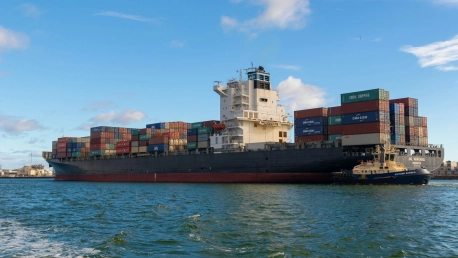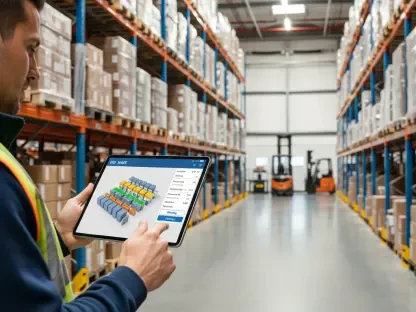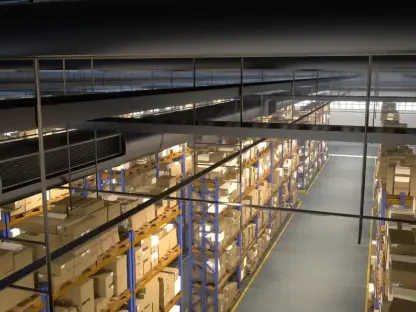In the vast economic landscape of North America, cross-border trade emerges as a crucial dynamic force, knitting together a combined GDP that surpasses the formidable $29 trillion mark. It stands as both a testament to interdependence and a vital engine of growth, pulling the United States, Canada, and Mexico into a robust financial nexus that shapes the lives of millions and the fortunes of countless businesses across the continent.Disturbances in global supply chains and an uptick in production costs, particularly in Asia, have spurred a strategic shift among North American businesses. This turn of the tide has seen an embrace of nearshore production to leverage the inherent benefits of geographical proximity, skilled labor, and the reassuring presence of established trade agreements.
Nearshore Production and the Importance of Proximity
The Shift to Nearshoring
Nearshoring, the process of transferring business operations to nearby countries rather than distant ones, has garnered significant interest as a strategic move for North American companies. This business decision is anchored in the quest for increased control over manufacturing processes, tighter supply chain management, and a response to the rising nationalism in trade policies.The impetus for this surge in nearshoring activities is multifaceted. Companies are enticed by the promise of better oversight, shorter transportation times, and nimble responses to market changes. They also seek to capitalize on the cultural and regulatory alignment while mitigating the challenges posed by time zones, language barriers, and disparate legal frameworks that often complicate overseas operations.
Impact of Nearshoring on North American Trade
The shift toward nearshoring is transforming North American trade dynamics, fostering the development of manufacturing centers strategically positioned to maximize commercial connections. This trend enhances economic cohesion and strengthens regional industries.Focusing on efficiency and supply chain resilience, businesses have eagerly embraced nearshoring — relocating production to be nearer to their customer base. This strategy slashes shipping durations, reduces transportation expenses, and improves inventory management. As a result, these companies are experiencing operational improvements that positively impact their financial performance.Nearshoring has emerged as a powerful strategy for companies to address logistical challenges and better cater to consumer demands. By shortening the distance goods travel, businesses can respond more swiftly to market changes, ensuring a steady flow of products to consumers. This approach not only streamlines operations but also contributes to the economies of neighboring countries, creating a symbiotic regional trade ecosystem that benefits all involved.As businesses continue to pursue nearshoring, the economic landscape of North America is likely to experience further integration, leading to more robust supply chains and reinvented trade frameworks that promise to endure.
The Role of Free Trade Agreements
Introduction to USMCA
The inception of the USMCA ushers in a new chapter for North American trade, updating and strengthening the foundation laid by NAFTA. This modern agreement introduces revamped rules designed to boost investments and foster a robust trading environment. It provides a stable and predictable landscape for businesses engaging in cross-border transactions within North America.The USMCA reflects a significant step in economic diplomacy, cementing a shared pursuit of economic vitality among the US, Canada, and Mexico. This revamped framework doesn’t merely overhaul its predecessor; it reinforces the infrastructure of trade relations, ensuring they remain resilient in the face of evolving global economic challenges. The agreement stands as a blueprint, enabling businesses to adeptly navigate through a complex international trading arena.With its forward-looking provisions, USMCA streamlines trade, addresses digital commerce, and strengthens labor standards. These enhancements reflect a contemporary understanding of trade necessities, positioning the three countries for continued growth and shared prosperity. The harmonization of regulations and practices under this agreement is a testament to the collective commitment of the United States, Canada, and Mexico toward a mutually beneficial economic future.
Duty-Free Exchange and Manufacturing Integration
The United States-Mexico-Canada Agreement (USMCA) establishes a dynamic commercial environment, essentially lifting tariffs on a host of duty-free products. This facet of the accord serves as a catalyst for businesses, reducing financial hurdles and promoting fluid trade that fortifies economic ties among these nations.Within its framework, the USMCA fuels industrial synergy throughout North America. It unlocks access to Mexico’s thriving economy, inviting companies with tax incentives that are too good to pass up. This strategic move allows businesses to optimize their manufacturing processes while engaging with a burgeoning market of consumers.One of the core advantages of the agreement is the fostering of economic interdependence that benefits all parties involved. For companies, it translates into lower operational costs and expanded market reach. The pact empowers businesses to relocate their production bases with confidence to any of the member countries, leveraging competitive advantages such as labor cost, logistics, and market proximity.The USMCA doesn’t just encourage commerce; it strategically reconstructs it across the North American landscape. Its policies are laying the groundwork for an integrated economy marked by advanced manufacturing hubs and agile supply chains that resonate with the contemporary needs of international trade. The agreement thus becomes a beacon for businesses looking to thrive in a harmonized North American market.
Navigating the Risks of Cross-Border Trade
Understanding Policy Risks
In the dynamic world of international trade, policies like Section 321 are crucial yet can pose challenges, altering cost structures significantly when they change. Modifications in these policies necessitate companies to promptly adjust their strategy and operations to stay competitive.Businesses need to be both aware and agile. Keeping a finger on the pulse of ever-evolving regulations and having the ability to adapt swiftly to these changes is not just wise but necessary for companies to preserve their edge in an increasingly competitive global marketplace.It falls upon businesses engaged in cross-border commerce to stay alert to such regulatory changes. This could mean reengineering logistics, revising supply chain partnerships, or exploring new markets to offset new costs or capitalize on tariff relaxations. Staying informed through trade associations, legal advisories, or government updates is part of this vigilance. Moreover, investing in technology that provides real-time data and analytics can enable businesses to respond more effectively to these regulatory shifts.Ultimately, trade policies like Section 321 may evolve to reflect broader economic goals, security protocols or trade relations; thus, businesses must be ready to respond to these changes to optimize their operations and sustain growth.
Technology and Logistics in Trade Operations
Successfully managing cross-border trade hinges on the advanced technological expertise needed to maintain continuous operation and oversight. Companies leverage state-of-the-art software and data analytics to efficiently orchestrate international logistics, staying ahead of any potential losses or inefficiencies that could arise. The complex process of tracking and controlling the movement of goods across countries is vital for the health of global commerce.This is where the value of experienced logistics providers comes into sharp relief. Businesses that partner with these specialists can navigate customs and border protocols more smoothly, minimizing the typical complications associated with such activities. This partnership not only leads to smoother operations but also boosts productivity by reducing the delays and hurdles that can slow down trade.Expert logistics partners are essential in unraveling the complexities of international transport and trade. By integrating their insights and capabilities, companies are better positioned to respond to the ever-evolving demands of global markets, ensuring their supply chains are robust and responsive. Although the landscape of cross-border trade is fraught with potential pitfalls, with the right technological tools and partnerships, businesses can facilitate a seamless flow of goods across borders.
Spotlight on Key Logistics Providers
ANDY and Polaris Transportation Group
In the realm of international markets, ANDY stands out with tailored solutions that have secured a unique position in cross-border services. This company is celebrated for its dynamic culture and commitment to fulfilling promises with both speed and precision. The personalized services offered by ANDY have led to a track record of high customer satisfaction and loyalty. They pride themselves on being a comprehensive source for meeting the diverse needs of their clients.Complementing ANDY’s offerings, Polaris Transportation Group brings a wealth of knowledge to the table when it comes to intricate customs regulations. Polaris is an innovator in the logistics field, embracing state-of-the-art technologies such as robotic process automation to provide a range of services. With their focus on both high-tech solutions and deep knowledge of customs compliance, Polaris ensures that their shipping and logistics tasks are performed with exceptional efficiency and trust.Together, ANDY and Polaris Transportation Group represent a powerful synergy for businesses needing dependable, sophisticated logistic services. Their combined strengths in technology, customer service, and compliance create a seamless experience for clients navigating the challenges of global trade.
Sunset Transportation’s Cross-Border Services
Sunset Transportation is setting a new standard in the logistics sector. Rooted in strong family origins, it provides an extensive suite of services, including import/export coordination, warehouse management, and supply chain optimization. The company prides itself on strategic locations throughout North America, with significant points in Canada and a growing presence in Mexican regions like Laredo and Querétaro.The firm’s astute location choices form a critical network for facilitating trade, especially between the U.S. and Mexico. By integrating thorough logistical expertise with deep market knowledge, Sunset Transportation ensures efficient and strategic transit points. These hubs are vital for maintaining the flow of goods across borders and underscore the company’s role as a linchpin in international trade.With localized service and a keen eye for market demands, Sunset Transportation not only navigates but also shapes the landscape of North American logistics. Its ability to adapt and build upon its family-based ethos while expanding in key trade areas reflects a dynamic combination of tradition and innovation in the transport sector.
Strategic Partnerships for Trade Success
Importance of Expert Partnerships
To successfully navigate the complexities of trade agreements like the USMCA, forming partnerships with knowledgeable cross-border service providers is crucial. These experts serve as navigators for businesses diving into the intricacies of international trade, particularly within the vast North American marketplace.These strategic partnerships equip companies with the insights and tools necessary to optimize their operations and drive efficiency, ensuring that they can not only keep up with but also capitalize on the dynamic nature of cross-border trading. By relying on the expertise of these service providers, businesses are better positioned to harness the full potential of trade agreements, turning challenging regulations into opportunities for growth.Engaging with such seasoned allies is more than just beneficial; it’s a strategic move for any company aiming to expand its trading horizons. The guidance provided by these experts often means the difference between getting lost in a web of international regulations and finding a streamlined path to commercial success. As the global marketplace becomes increasingly competitive, these collaborations become the linchpin for companies looking to thrive within the North American trade landscape.
Leveraging Robust Technology and Understanding Regulations
In an epoch defined by rapid technological evolution, harnessing robust technology underpins the successful maneuvering of cross-border trade logistics. The deployment of advanced systems equips businesses with a prescient lens – gazing at the horizon of trade complexities and charting a course that avoids the turbulent waters of logistical upheaval.Simultaneously, a sagacious grasp of the regulatory environment is non-negotiable. Being both literate and fluent in the language of trade regulation empowers businesses to not just survive but thrive amidst the mercurial nature of international trade agreements, policies, and compliance mandates. It is this duality of technological leverage and regulatory savvy that anchors North America’s cross-border trade in a state of sustained prosperity and resilience.









